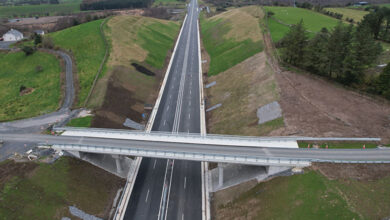Public transport: Dublin projects coming at the right time

With public transport passenger numbers reaching all-time highs in Dublin, the increased capacity promised by the transport infrastructure projects included in the National Development Plan are arriving at a crucial time for the capital city.
Quarter three of 2019 saw 61 million public transport trips taken in Dublin, an 8.8 per cent year-on-year rise from Q3 2018. The expansion of the Luas’s capacity has been the greatest driver of that growth, with numbers for the service alone up by 15.1 per cent in the same period. The Luas service now accounts for 19.9 per cent of overall trips, up from 18.8 per cent.
Dublin Bus still accounts for the vast majority of trips taken in the capital, totalling 63.7 per cent in Q3 2019. Irish Rail services, including the DART, saw their share of the total fall for the fourth consecutive quarter, with their trains accounting for 14.7 per cent of trips taken. The remaining 1.7 per cent was made up by the 1.6 million Bus Éireann trips taken in Dublin. National figures are also up for 2019, with 290 million public transport trips taken throughout the year, a rise of 24 million overall.
The increase in numbers show a city whose citizens are receptive and in need of increased public transport capacity. Indeed, Q2 of 2018, the second quarter in which the Luas Cross City service was operational, saw Luas trips exceed 10 million for the first time. Residents and government alike will hope that the improvements to Dublin’s public transport infrastructure included in the National Development Plan will satisfy the need in an ever-growing city.
BusConnects
A redesign to the proposed BusConnects network was announced in October 2019, with a public consultation having taken place following complaints that some users would be left without a direct route to the city centre and sufficient access to schools, colleges and hospitals. The most frequent routes of the new service will operate along “spines”; the original plan had seven spines, but the new and revised route map now sees eight spines serving the county.
DART expansion
DART expansion will now see the routes of the rapid transport system end at Maynooth, the M3 Parkway past Dunboyne, Kildare, Dundalk and Greystones. Lines will be electrified as far as Maynooth, the M3 Parkway, Hazelhatch, Drogheda and Greystones.
Questions had arisen about the expansion’s plan to close five level crossing, which have been cited as a solution to the bottlenecks caused by rush hour traffic coinciding with the increased frequency of services. The closures are included in the initial plan, but it stated that any definitive closure will be subject to review by both the National Transport Authority and Dublin City Council.
With peak time DART capacity currently 26,000 passengers per hour, it is estimated that the current plan would increase that figure to 60,000. Should the currently shelved plans to incorporate an underground system into the DART service ever come to fruition, this figure would rise to around 80,000.
MetroLink
The MetroLink “preferred route” was published in March 2019 with the envisioned line now terminating at Charlemont Luas stop rather than continuing to Sandyford as had been originally planned. This decision was taken in order to avoid disruption the Luas’s green line, which will itself be improved instead.
The cost of the MetroLink was given as €3 billion when the National Development Plan was published in 2018, but with the project now significantly shorter, it is unclear if that final figure will be lower. Construction of the mostly underground system is due to begin in 2020 and expected to be completed in 2027.
Major Dublin transport infrastructure projects outlined in the National Development Plan 2018–27
- DART expansion: €2 billion
- MetroLink: €3 billion
- BusConnects: €2.4 billion
- Dublin Port
Alexandra Basin redevelopment: €230 million - Dublin Airport
Second runway: €320 million





